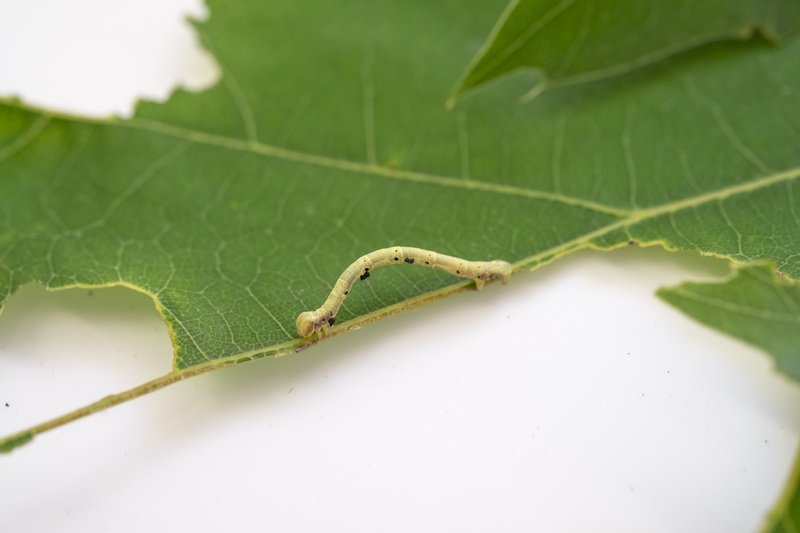
Pesticides can seem like a quick fix, but they can also have long-term impacts on your garden ecosystem. Instead of resorting to these chemicals, let’s explore some **natural alternatives** that can help you keep inchworms at bay while nurturing a thriving garden. It’s all about understanding these pests, their habits, and how you can gently guide your garden back to health.
Understanding Inchworms: The Little Green Menace
Inchworms, or **loopers**, are the larvae of moths in the Geometridae family. They earn their name from their unique way of moving—by looping their bodies, they inch along branches and leaves, making them seem like they’re dancing. This movement is not just charming; it’s a technique they use to camouflage themselves against predators.
You might be surprised to find out that inchworms feed on a variety of plants. They’re particularly fond of deciduous trees and shrubs but can also munch on garden flowers. If left unchecked, a few inchworms can quickly turn into a serious problem. You’ll notice small holes in the leaves, and in larger infestations, entire branches can be stripped. Recognizing the signs early is key to effective management.
Why Avoid Pesticides?
You might be wondering, “Why should I skip the pesticides?” Here’s the thing: while pesticides can be effective, they also come with downsides. Chemical residues can linger in the soil and plants, potentially harming beneficial insects and pollinators like bees and butterflies. Not to mention, they can pose risks to humans and pets, especially if misapplied.
By avoiding pesticides, you’re not just protecting your garden; you’re also contributing to a healthier ecosystem. Natural pest management encourages biodiversity, promoting the balance of species that keep your garden robust. Plus, many alternatives can be just as effective as chemical options, without the harmful side effects.
Natural Predators: The Garden’s Bodyguards
One of the best ways to manage inchworms is by inviting their natural predators into your garden. Birds, wasps, and even some beetles thrive on inchworms, making them excellent allies in your battle against these pests.
To attract these helpful creatures, consider planting a variety of flowers and shrubs that provide food and nesting sites. For instance, you can plant milkweed to draw in parasitic wasps, which lay their eggs inside inchworms, then feast on them when they hatch. It’s like nature’s very own pest control service!
In a pinch, you can also buy beneficial insects online or at local garden centers. Just make sure you do your research to ensure they won’t disrupt your garden’s balance. By fostering a friendly ecosystem, you minimize the chances of a major inchworm infestation.
Handpicking: The Classic Method
This may sound simple, but handpicking inchworms can be surprisingly effective. If you spot an inchworm on your plants, just pluck it off and drop it into a bucket of soapy water. This method works best in the early morning or late afternoon when inchworms are most active.
Honestly, while it can feel tedious, the satisfaction of knowing you’ve removed unwanted pests from your plants is pretty rewarding. Plus, it’s a great way to connect with your garden. Take a few minutes each day to check on your plants and enjoy the peace of nature while you’re at it.
Beneficial Homemade Sprays
If handpicking isn’t your style, there are plenty of **homemade sprays** you can whip up using common household ingredients. For example, a mixture of **water, dish soap, and garlic** can deter inchworms. Just mix a tablespoon of dish soap and a few crushed garlic cloves into a quart of water, let it sit overnight, and strain it. Spray this solution directly on the leaves where you see inchworms.
Another effective option is using a **pepper spray** made from hot peppers and water. Blend a few hot peppers with water, strain, and then spray on the affected plants. This works because inchworms dislike the spicy taste and smell. Just be sure to test any spray on a small area of the plant first to make sure it won’t cause damage.
Encouraging Healthy Plants
Keeping your garden healthy is one of the most effective ways to prevent inchworm infestations. Strong plants are less susceptible to pests. To encourage growth, start with good soil, proper watering, and appropriate sunlight for each type of plant.
Consider using **compost** to enrich the soil. Compost not only provides essential nutrients but also promotes beneficial microorganisms that help plants fight off pests and diseases. Also, practice crop rotation and diversity in your garden to prevent inchworms from establishing a colony in one location.
Sometimes, the best defense is a good offense! By ensuring your plants are strong and healthy, you’ll give inchworms a much tougher time.
Regular Monitoring and Maintenance
Lastly, regular monitoring is crucial in inchworm management. Make it a habit to check your garden frequently for signs of inchworms or their damage. Early detection can save you a lot of hassle down the road.
Keep an eye out for **webbing**, which might indicate the presence of inchworm larvae. Additionally, adjusting your watering and care routines can help manage stress on plants, making them less appealing to pests. This proactive approach will keep your garden thriving and inchworm-free.
Managing inchworms without pesticides is entirely possible with a little knowledge and effort. By understanding their habits, inviting beneficial predators, trying handpicking, and using homemade sprays, you can protect your garden and the environment at the same time. It’s about creating a thriving ecosystem that encourages balance rather than resorting to chemicals.
So, next time you spot an inchworm, remember there are natural ways to manage them. It’s all about working with nature, not against it. Happy gardening!

